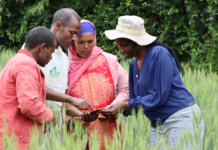By Wallace Mawire
Mana Pools National Park, Zimbabwe
Zimbabwe’s Division of Tsetse Control Services in the Ministry of lands, Agriculture, Fisheries, Water and Rural Development under the Department of Veterinary Services is to conduct a feasibility small scale pilot study to use drone technology in some areas still to be cleared of tsetse-flies which have been a menace to human beings and impacting on livestock production.
Dr William Shereni, Director for the Tsetse Control services division confirmed during a media tour with Journalists to previously tsetse infested areas and some remaining tsetse areas his division is in the process of procuring a big drone to be used for aerial spraying at a cost of approximately US$35 000.
Dr Shereni said that the division will in the first instance conduct a pilot study at Rekomichi Tsetse Research Station in Mana Pools in the Zambezi Valley. The station is renowned to be a centre of excellence for tsetse control research in the SADC region.
He said that tsetse research began in the 1960s with evolution of baits and screening of odours and insecticides .The research was in collaboration with Bristol University and Natural Resources Institute (Greenwich University) in the United Kingdom (UK).
Dr Shereni added that tsetse research has been focussed on two broad objectives such as the development of bait technology, generation of knowledge on tsetse physiology, ecology and behaviour and the use of drones for Sequential Insecticide Treatment (SIT) and Sequential Aerial Treatment (SAT),use of Geographic Information Systems (GIS) and remote sensing technology for mapping, analysis and modelling.
“We have been using small winged aircraft for aerial spraying hired from Agricair (Pvt) Ltd and this has proved to be costly. By procuring our own drone, we hope to cut costs for our interventions, ”Dr Shereni said.
The tsetse control services division also works with the department of veterinary services to control tsetse-flies using chemicals at dipping points to kill tsetse-flies and ticks. During the media tour, the tsetse control division updated Journalists from various media houses in Zimbabwe on some of its activities it is conducting to achieve total tsetse fly control in the country.
Some of the activities included touring target treatment and odour manufacturing factory at the University of Zimbabwe (UZ) in Harare, where materials are produced for use in the field where tsetse fly eradication initiatives are on-going. Visits were made to demonstration sites at dip tanks for example at Kasvisva Dip Tank at Siakobvu, just to mention a few.
Some of the areas visited during the media tour include Hurungwe, Siakobvu and Mana Pools.
Mana Pools National Park is in the far north of Zimbabwe. It includes the south bank and islands of the Zambezi river, which forms the border with Zambia. The park is known for wildlife visibility beside the river and in the flooding plains. Large populations of elephants, hippopotamus and Nile crocodiles gather at sunrise in the long pool. In the park’s south, lions wait for prey around the waterhole at Chitake spring.
The national park due to its large numbers of wildlife is one of the remaining hotspots still to be cleared from tsetse-fly infestation and also to minimize the spread of the flies to domesticated livestock, especially cattle in the nearby areas and other outlying border areas.
Siakobvu is in Mashonaland West province of Zimbabwe and lies 220km Southwest of Kariba town via Gache Gache and 357km via Karoi.
Dr Shereni also informed the media that tsetse control in Zimbabwe was started in the 1920s using bush clearing and game elimination.
He said that in the 1940’s modern insecticides were discovered leading to the development of techniques based on the use of chemicals.
He added that from that time till the 1980’s ground spraying was the mainstay of tsetse control.
Since 1980,the division says that the Area-wide, Integrated Pest Management (AW-IPM) concept involving ground spraying, aerial spraying, bait technology using targets and cattle dipping was adopted.








